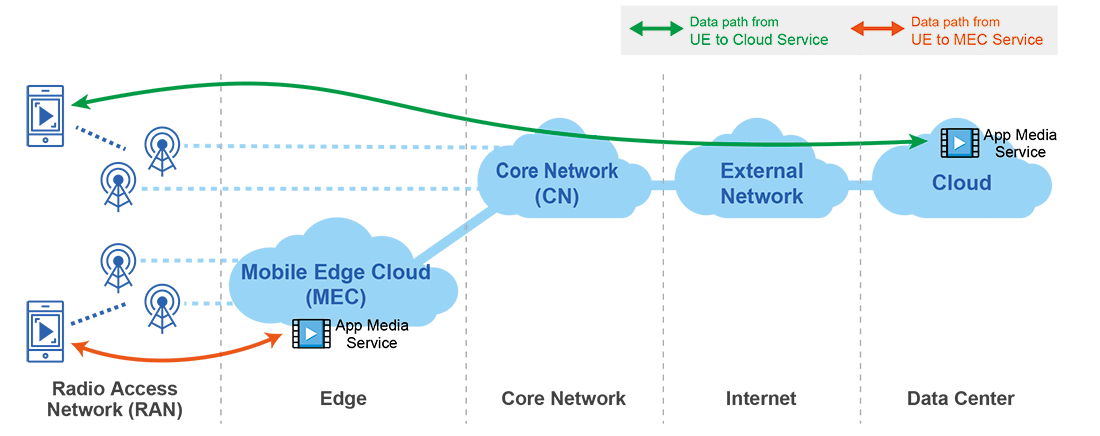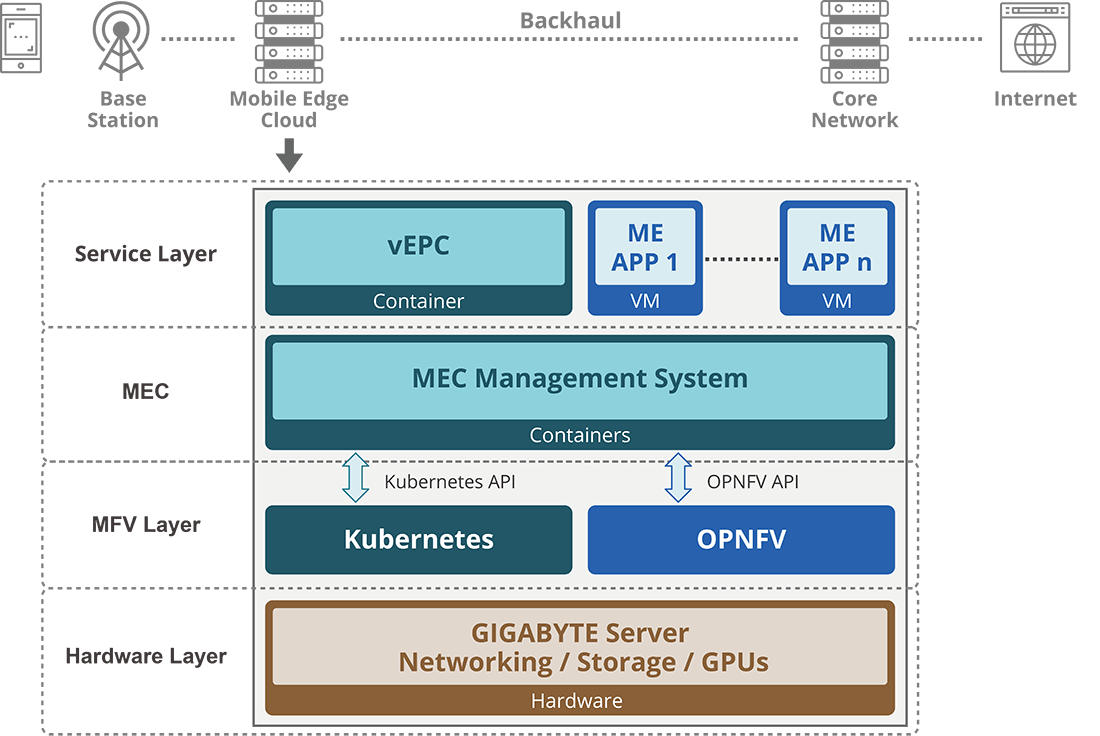An Immersive VR Stadium Experience with 5G eMBB Technology
eMBB (Enhanced Mobile Broadband) technology can deliver ultra-high wireless bandwidth capabilities, and can be used to provide a fully immersive VR front-row concert or sports experience to all attendees, even in the cheap seats and in rear VIP rooms - or if they missed out on a ticket altogether
Email Sales
eMBB for High Bandwidth & Low Latency Media Streaming
Enhanced Mobile Broadband (eMBB) is a new service category of 5G that defines a minimum level of data transfer rate, promising to deliver both vastly increased bandwidth and decreased latency compared to existing 4G services. This technology will enable new applications such as 8K video streaming and truly immersive VR and AR.
One potential "killer" application of 8K video or 360 VR will be large spectator events such as sports games or concerts, where spectators will be able to experience a front row view of the action, even if they are located far away from the action in rear seats, in VIP or other rooms nearby, or even in other locations such as sports bars or restaurants.
Real World Examples
Live VR Concert Experience
In 2019 as part of Taiwan's 5G Pilot Team, GIGABYTE helped successfully build and test an immersive VR stadium experience at Taipei's new Pop Concert Hall Center. Spectators in the 2F VIP room can experience a 360 degree front row view of concert via wireless VR headsets. The system used a 5G MEC on GIGABYTE's servers to store + route video locally, eliminating latency from network back-haul.

The Challenges of Implementing Live VR with eMBB
High bandwidth applications such as 8K video or 360 VR will be very sensitive to network performance, with any interruption having a significant negative impact on user experience. For example, when using VR a delay between action and response – such as turning your head to view a scene from a different angle – can result in motion sickness. Users can experience dizziness and nausea when latency is over 20ms. For a large event such as sports game or concert, meeting latency thresholds for thousands or tens of thousands of users will be key.

Live VR with eMBB
The increased bandwidth requirements for 8K video or 360 degree VR will also result in vastly increased amounts of data being transferred back and forth over network back-haul, from the user device to the network operator's core data center. In a mass spectator event where tens or even hundreds of thousands of network users will be gathered in close proximity, the back-haul network traffic load will become enormous, placing a huge strain on network transport infrastructure.
Therefore, to meet these service and latency requirements using an existing endpoint to core model, especially in locations such as concert halls or stadiums, operators may need to spend huge amounts of money to upgrade their existing front to back-end network infrastructure. Since these kinds of big events will occur only sporadically, this can result in wasted resources when this extra capacity is lying idle.
The Solution for an Immersive VR Stadium Experience
A Local MEC for Combined Network Services and Video Streaming
The answer to these issues can be to build a local edge cloud (MEC: Multi-access Edge Computing / Mobile Edge Computing / ), deployed on GIGABYTE's server hardware. It can enable 360 degree 8K video to be processed and stored logically and physically local to the venue. The network can route data traffic within the venue, avoiding the delay and cost associated with backhaul across the network. In addition, a locally based MEC provides SON (Self Organizing Network) functionality to further improve service quality.

Traditional Network Topology vs MEC
GIGABYTE's G-Series GPU Series such as the G591-HS0 feature support for up to 32 GPU cards – providing powerful GPU compute capabilities to build a combined VR stitching / processing server for collecting, processing and transmitting 8K 360 video, and support for 8 x PCIe x16 networking cards for high bandwidth video transfer capabilities. 32 x PCIe slots can also be utilized instead for FPGA cards for network packet acceleration capabilities. The server also supports dual Intel Xeon Scalable processors for up to 56 cores per system, providing a powerful compute platform for container based Network Functions Virtualization, allowing the G591-HS0 to be adopted as the hardware based of a combined MEC and vEPC (Virtual Evolved Packet Core) server to deliver and manage network traffic locally without it needing to be transmitted back to the operator's core data center over network back-haul.

MEC Hardware + Software Stack
Network Slicing for Diversified Service Requirements
Network slicing is an architecture that enables different virtualized and independent logical networks on the same physical network infrastructure, in order to meet diversified service requirements.
Network slicing enables network elements and functions to be easily configured and reused in each different slice to meet a specific requirement. One slice appears like a self-contained network that includes the core network and the RAN. However, each of these slices can have its own network architecture, security, quality of service and network provisioning as a result of the network virtualization software implementations. This allows one network slice to provide low-security, low-bandwidth services (such as for mMTC), while another slice can provide high-security, high-reliability services (such as for URLLC).

Network Slicing
The fully cloud-native architecture of 5G and MEC is ideal to support network slicing, allowing for a eMBB network to run on the same physical infrastructure as other 5G services to save on infrastructure investment and network operating costs. Network slicing is the key to meeting 5G's diverse requirements, and is a perfect solution to seamlessly integrate a high bandwidth 5G network for live media streaming together with other applications with different network service requirements such as for URLLC (autonomous driving) or mMTC (smart city IoT network).
GIGABYTE Server Hardware for a eMBB / MEC Platform
1/1
Combined MEC + Video Stitching Server
Supports up to 32 x GPU cards to build a combined VR stitching / processing server for 8K 360 video. Supports up to 8 x PCIe x16 networking cards for high bandwidth video transfer capabilities. Dual Intel Xeon Scalable processors providing powerful compute capabilities for container based NFV
Related Technologies
5G is short for "5th Generation", the name for the next generation of mobile cellular networks. 1G networks brought us the first cell phones, 2G networks allowed for text messaging, and 3G networks introduced mobile internet for the first time. Currently in use is 4G which has been deployed globally since 2009. 4G LTE (Long Term Evolution) is the latest version of 4G that allows a download rate of up to around 200Mbps. However, 4G networks have just about reached the limit of their capabilities at a time when users want even more data and faster speeds for their cell phones and other devices. Therefore, the need for a new type of network technology that can provide faster speeds and transmit more data to more users is pressing.
Technically speaking, "5G" is defined only as a set of standards – such as latency, network connection density, and data transfer rate – that the next generation of mobile networks should be able to achieve. Once these standards can be met, 5G should be able to handle up to 1000 times more traffic than today's networks, and be up to 10 times faster than 4G LTE.
To be able to meet these standards, various new technologies will be needed. For example, to support a huge increase in the number of online devices, a new band on the radio frequency spectrum (between 30 – 300GHz) will be opened for use. However, this band of radio frequency consists of "millimeter waves" which are more easily blocked by buildings and absorbed by plants and rain. Therefore, thousands of small base stations ("small cell technology") will be needed to be installed, forming a relay team to transmit signals around obstacles. In addition, to support the latency requirements of 5G, Multi-access Edge Computing technology (MEC) will need to be introduced on a large scale into cellular networks so that the data that the user needs (such as a streaming video) can exist physically closer to the user.
What is vEPC (Virtual Evolved Packet Core)? A Virtual Evolved Packet Core (vEPC) is a framework for mobile networks' voice and data processing and switching that is implemented by Network Functions Virtualization (NFV), which virtualizes the functions of an Evolved Packet Core (EPC). The vEPC framework has been in use for 4G LTE mobile networks and will also form a key part of upcoming 5G network architecture. 1G mobile networks utilized voice functions only. 2G and 3G network architectures processed and switched voice and data through two separate sub-domains, complicating network management and restricting functionality for the end user. 4G introduced EPC, unifying voice and data on the same backbone Internet Protocol (IP) service architecture, allowing "always on" internet connectivity for mobile users and simplifying management for mobile network operators. However, implementing an EPC required expensive proprietary hardware & software infrastructure. Network Functions Virtualization moves the functions of the EPC to the software domain and allows it to be run on low-cost Commercial Off-The-Shelf (COTS) servers.
What is Multi-access Edge Computing (Mobile Edge Computing)? Multi-access Edge Computing (MEC), also known as Mobile Edge Computing, is a network architecture that enables cloud computing capabilities and an IT service environment at the edge of a cellular network. MEC technology is designed to be implemented at cellular base stations or other edge nodes, and enables flexible and rapid deployment of new applications and services for customers. MEC is ideal to be used for the next generation of 5G cellular networks.
Bring Your Ideas Faster to Fruition
Email Sales




















